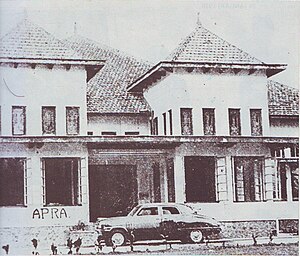APRA Coup d'état
| APRA Coup d’état | |||||||
|---|---|---|---|---|---|---|---|
| Part of Indonesian National Revolution | |||||||
 Siliwangi Division headquarters occupied by the APRA force |
|||||||
|
|||||||
| Belligerents | |||||||
|
|
Legion of Ratu Adil (APRA) | ||||||
| Commanders and leaders | |||||||
| Colonel Sadikin Major General Engles |
Captain (ret.) Westerling | ||||||
| Strength | |||||||
|
Siliwangi Division 4,500 TNI troops |
2,000 APRA troops | ||||||
| Casualties and losses | |||||||
| Approximately 100 dead | Unknown | ||||||
The APRA coup d'état was a coup d'état by Raymond Westerling's Legion of Ratu Adil (APRA) to capture Bandung and Jakarta, and to overthrow Sukarno’s unitary Republic of Indonesia. Westerling was a demobilized Dutch Captain of the KNIL (Royal Netherlands East Indies Army), who sought to preserve the federal Republic of the United States of Indonesia, which retained the support of the Netherlands and various minority elements. Westerling's forces succeeded in capturing Bandung in the early hours of January 23, 1950.
Simultaneously, the APRA infiltrated Jakarta as part of a coup d’état to overthrow the RUSI Cabinet. Their plan was to arrest and assassinate several prominent Republican figures including the Defense Minister Sultan Hamengkubuwono IX and Secretary-General Ali Budiardjo. However, Westerling’s forces in Jakarta were killed or captured by the Indonesian army and police forces. The APRA was forced out of Bandung, while Westerling escaped to Singapore. After a mopping up campaign the Legion of Ratu Adil had ceased to function in February 1950. The coup d'état led to the downfall of Sultan Hamid II and accelerated the integration of the RUSI into the Republic by August 17, 1950.
Prior to the transfer of sovereignty on December 27, 1949, a RUSI Cabinet consisting of both Republican and Federalist members was formed on December 17, 1949. This Cabinet was headed by Prime Minister Mohammad Hatta and included 11 Republicans and five Federalists including the pro-Dutch Sultan Hamid II. Ultimately, this federal government was short-lived due to conflicting differences between the Republicans and the Federalists as well as growing popular support for a unitary state.
...
Wikipedia
